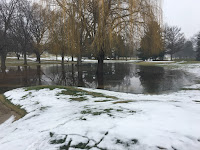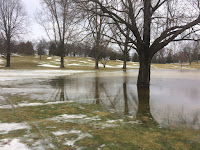It's always hard to spend time making a blog update with so much going on with the course. With the recent stretch of rainy weather all of us at the shop have had a chance to get caught up with various odds and ends inside. It also gives me this opportunity to say a little about all that has been going on outside.
Fairway aerification was successfully completed on April 23rd and 24th. Everything went perfectly for us. The weather was ideal leading into Sunday night and continued into Monday, allowing the cores to perfectly dry before we ground them up. The rain that followed later in the week was also perfect for washing in any remaining soil. The almost unrelenting rain we have been getting since isn't great for playing but it won't negatively impact the fairways in the long run.
We have been mowing the greens, tees, fairways and rough as needed. It has been a really good spring for root growth on most of the greens. Many times when I take a plug out while setting cups it looks like something out of a textbook. It's too early to tell what kind of summer we will have but we should be going in strong.
Dr. Williamson and Dr. Hogg have been out multiple times to monitor the bee hives on 3. The first few trips they supplied the bees with a simple mix of sugar and water to ensure they had a supply of food. On the most recent trip they also brought a frame with honey for each hive. They were very encouraged with the hive progress as the bees had already begun forming some comb.
The bees aren't the only new wildlife at Blackhawk. Late one morning I spotted what I believe is a great horned owl on the ground at the back of the range.
I also snapped this picture of of a butterfly off the right side of 12 green.
My Google searching leads me to believe it is a Spicebush Swallowtail. The Blue Bird house on the back side of the bathrooms on 6 also has a resident pair of Blue Birds. It's amazing to see the variety of birds that call Blackhawk home.
We have already had a few of our older part-timers come in to help as needed. A lot of what we are able to get done is thanks to their help. In the coming weeks we will also see our summer roster filled out. We are happy to have a few people returning from last year and hope to have the new crew members trained before June.
If you have already had a chance to play this year I hope you enjoyed your time. If you haven't played yet now is a perfect time to enjoy a round; if you are anything like me it's the best time of year for golf as the trees don't have many leaves and my errant shots go a bit further. Thanks for reading and I hope to see you out and about on the course.












